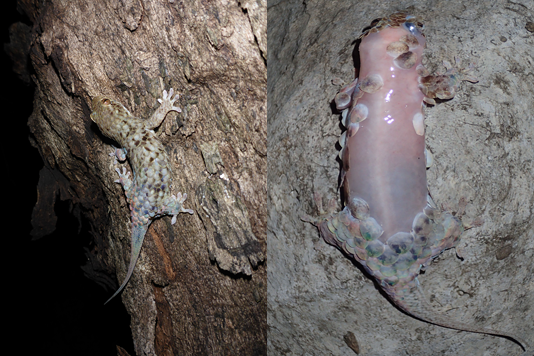New Animal Species: Scaly Gecko In Madagascar Discards Its Large Scales To Avoid Being Caught

Even as the diversity of known life-forms on Earth, especially the bigger animals, is increasingly shrinking for a variety of mostly anthropogenic, or human-made reasons — from habitat destruction to poaching and everything in between — there is at least a modicum of pleasure to be found in the discovery of new species that coinhabit the planet. Even if it is a gecko. Oh, also, if you suffer from herpetophobia, you might not want to read this.
The newly discovered Geckolepis megalepis is found in northern Madagascar and was described for the first time in a paper published Tuesday in the journal PeerJ. And like all geckos of the Geckolepis (lepis means scales) genus, the body of G. megalepis is covered in scales. The second part of its name is based on the fact that its scales are the largest known, in both relative and absolute terms, for any member of its genus.
It is a commonly known fact that lizards can leave their tails behind while escaping from a predator. But the Geckolepis genus takes this evasion practice a few steps further, leaving behind a lot of its fish-scales in the predator’s mouth while wriggling away to safety from the jaws of death. And according to a statement by the researchers, G. megalepis is “the master of this art,” making them very difficult to study because they are extremely difficult to catch. Even if they are caught, the fact that they lose many or most of their scales in the process makes it challenging to distinguish different species.
For the identification of G. megalepis as a distinct species, the researchers — from Zoologische Staatssammlung München, Hessisches Landesmuseum Darmstadt and Zoologisches Institut, Technische Universität Braunschweig, all of which are in Germany, and Sam Houston State University in Huntsville, Texas — used 3D X-rays to examine the skeletons of geckos. Some features of the skull of the new species made it stand apart from its close relatives.
“The skin of fish-scale geckos is specially adapted to tearing. The large scales are attached only by a relatively narrow region that tears with ease, and beneath them they have a pre-formed splitting zone within the skin itself. Together, these features make them especially good at escaping from predators. Although several other geckos are able to lose their skin like this if they are grasped really firmly, Geckolepis are apparently able to do it actively, and at the slightest touch. And while others might take a long time to regenerate their scales, fish-scale geckos can grow them back, scar-free, in a matter of weeks,” the statement said.
The researchers put down the large size of the scales on G. megalepis to the hypothesis that they tear away from the lizard’s skin more easily than their smaller variants. The mechanism for their regeneration is not well understood, but could find potential applications in the field of human surgical medicine.
“What’s really remarkable though is that these scales—which are really dense and may even be bony, and must be quite energetically costly to produce—and the skin beneath them tear away with such ease, and can be regenerated quickly and without a scar,” Mark D. Scherz, lead author of the paper, said in the statement.
© Copyright IBTimes 2025. All rights reserved.




















